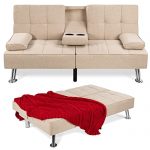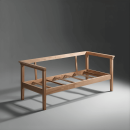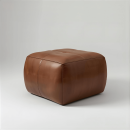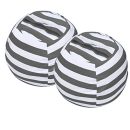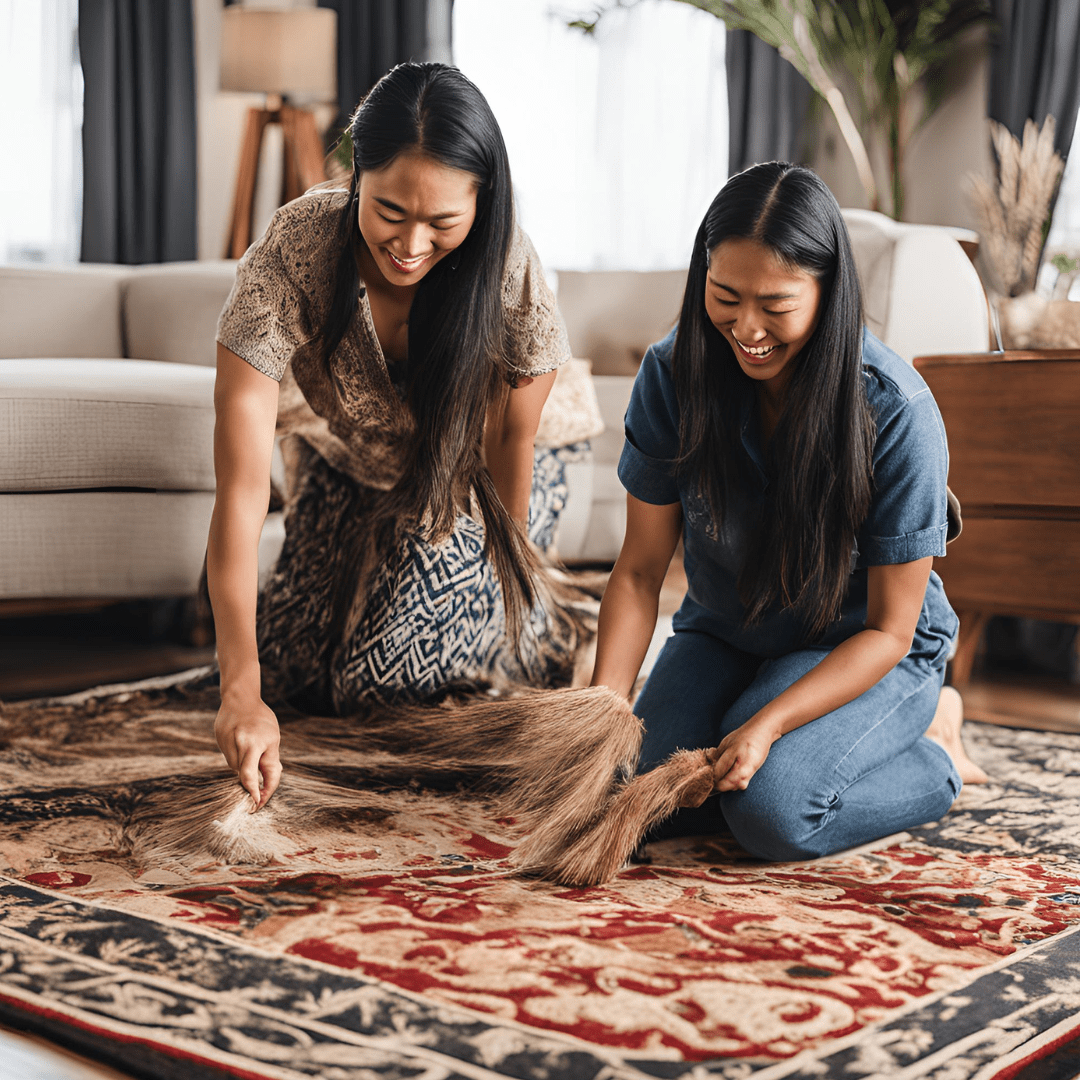
How Do Professionals clean Oriental rugs using specialized techniques like dusting, hand-washing, and controlled drying? They ensure delicate fibers remain intact.
Oriental rugs are prized for their intricate designs and craftsmanship. Proper cleaning is crucial to maintain their beauty and longevity. Professionals use specific methods tailored to the rug’s material and condition. First, they remove dust and debris using gentle tools.
Next, how to clean a rug at home by hand with mild detergent, ensuring no damage to the fibers. Controlled drying in a climate-controlled environment prevents shrinkage and color fading. This meticulous process helps preserve the rug’s vibrant colors and intricate patterns. Regular professional cleaning enhances the rug’s appearance and extends life, making it a valuable investment for any home.
In this guide, we will delve into the specialized techniques and tools that experts use to ensure that your oriental rugs remain vibrant and free from damage. From gentle vacuuming to deep cleaning methods, learn the essential steps by professionals to keep these exquisite textiles in prime condition.
Initial Inspection
Oriental rugs are prized for their beauty and craftsmanship. Professionals take special care to clean them. The first step is the Initial Inspection. This crucial phase helps determine the best cleaning method. It involves assessing the rug’s condition and identifying its materials.
Assessing Condition
During the initial inspection, professionals first assess the rug’s condition. This step helps identify any existing damage or areas that need special attention. Experts look for:
- Frayed edges
- Color fading
- Stains
- Worn areas
They also check for structural integrity. This means looking at the rug’s backing and foundation. Any weak spots are noted. This helps in planning the cleaning process. Professionals may also take photos to document the rug’s initial state.
Some rugs may have moth damage. This is common in wool rugs. Experts look for small holes or signs of larvae. They also check for mold or mildew, especially if the rug has been stored in a damp area.
Here is a table summarizing what they checked:
| Aspect | Details |
|---|---|
| Frayed Edges | Check for loose threads |
| Color Fading | Look for uneven colors |
| Stains | Identify types of stains |
| Worn Areas | Check high-traffic zones |
| Moth Damage | Look for small holes |
| Mold/Mildew | Check for damp spots |
Identifying Materials
Next, professionals identify the materials used in the rug. This is crucial because different materials need different cleaning methods. The most common materials are:
- Wool
- Silk
- Cotton
- Synthetic fibers
Wool is the most common material. It is durable and holds dye well. Silk rugs are luxurious but delicate. Cotton is often used in the foundation. Synthetic fibers are less common but can be found in some modern rugs.
Experts perform a burn test to identify materials. They take a small fiber and burn it. Wool smells like burning hair. Silk smells similar but leaves a finer ash. Cotton smells like burning paper. Synthetic fibers melt and form a bead.
Identifying materials helps in choosing the right cleaning solution. For example, wool requires a gentle cleaner and silk needs a special pH-balanced cleaner. Cotton can handle more robust cleaning methods. Synthetic fibers are usually the easiest to clean.
Here’s a quick reference table:
| Material | Characteristics | Cleaning Needs |
|---|---|---|
| Wool | Durable, holds dye well | Gentle cleanser |
| Silk | Luxurious, delicate | pH-balanced cleaner |
| Cotton | Often used in foundation | Robust cleaning |
| Synthetic fibers | Less common, easy to clean | Standard cleaner |
By understanding the materials, professionals ensure the rug is cleaned safely and effectively.
Dust Removal
Oriental rugs are beautiful and valuable pieces that need special care. Dust removal is a crucial step in maintaining these exquisite rugs. Professionals use various methods to ensure every particle of dust is eliminated, preserving the rug’s beauty and longevity.
Vacuuming Techniques
Professionals use specialized vacuuming techniques to clean Oriental rugs. They avoid using standard vacuum cleaners, which can damage delicate fibers. Instead, they use vacuums with adjustable suction and soft bristles.
Here are some key points:
- Low Suction Setting: High suction can pull fibers, so use a low setting to gently lift dust.
- Soft Bristle Attachments: These prevent damage to the rug’s surface.
- Vacuuming Both Sides: Dust can settle on the back, so they vacuum both sides.
Professionals also follow a specific vacuuming pattern:
| Step | Description |
|---|---|
| 1 | Start at the center and move outwards. |
| 2 | Vacuum in straight lines to cover all areas. |
| 3 | Repeat the process on the reverse side. |
These techniques ensure that the rug is thoroughly cleaned without any damage.
Beating Methods
Another effective method for dust removal is beating the rug. Professionals still use this traditional technique because it is highly effective.
Here’s how they do it:
- Hanging the Rug: They hang the rug on a sturdy line or rod.
- Using a Beater: A specialized rug beater, usually made of wood or plastic, is used.
- Gentle Beating: They beat the rug gently to avoid damaging the fibers.
Professionals follow a systematic approach:
| Step | Description |
|---|---|
| 1 | Hang the rug in an open area. |
| 2 | Beat the rug from the top down. |
| 3 | Shake the rug to release the remaining dust. |
This method effectively removes deep-seated dust that vacuuming might miss. Both vacuuming and beating ensure a clean and well-maintained Oriental rug.
Stain Treatment
Stain treatment is crucial for maintaining the beauty and longevity of oriental rugs. Professional cleaners use specialized methods to address various types of stains. They identify the stain type and apply the most effective cleaning solution. Ensures the rug’s fibers remain intact and vibrant.
Types Of Stains
Professionals encounter numerous types of stains on oriental rugs. Each stain demands a unique approach for successful removal:
- Food Stains: These include spills from sauces, oils, and beverages. They can be greasy or sticky, making them tricky to remove.
- Pet Stains: Common in homes with pets, these stains include urine, feces, and vomit. They not only stain but also leave unpleasant odors.
- Ink Stains: Pen or marker ink can seep deep into rug fibers. This makes it challenging to extract.
- Wine Stains: Red wine is notorious for leaving dark, stubborn marks on rugs.
- Dirt and Mud Stains: These are common in high-traffic areas. They can grind into the rug fibers over time.
Professionals assess each stain type before choosing the treatment method. This ensures the rug’s fabric and colors remain undamaged.
Cleaning Solutions
Professionals use specific cleaning solutions tailored to each stain type. These solutions are safe for oriental rugs and effective in removing stains:
- Enzyme Cleaners: Organic stains like pet urine and food. Enzymes break down the stain molecules, making them easier to remove.
- Vinegar and Water: A popular and gentle solution for light stains. Vinegar’s acidic nature helps dissolve stains without damaging the rug fibers.
- Detergent Solutions: Mild, pH-balanced detergents are effective on grease and oil stains. They lift the stain from the fibers without causing discoloration.
- Rubbing Alcohol: Useful for ink stains. Alcohol dissolves the ink, allowing it to be blotted away.
- Hydrogen Peroxide: Often used for tough, set-in stains like wine. It acts as a bleaching agent but must be used carefully to avoid color loss.
Professionals test each solution on a small rug area first. Ensures no adverse reactions occur. Proceed to treat the stain, blotting, and cleaning the area.
Washing Process
Professionals use a meticulous washing process to clean Oriental rugs. This ensures that the rugs maintain their color, texture, and longevity. The washing process includes several important steps to ensure the rug is thoroughly cleaned without damage.
Water Temperature
Water temperature is crucial in the washing process of Oriental rugs. Professionals typically use cold or lukewarm water. This helps with any color bleeding or fiber damage. Hot water can be harsh and may cause the dyes to run, leading to a faded and uneven appearance.
Cold water is gentle and effective in removing dirt and grime without harming the delicate fibers. Professionals often test the water temperature before starting the cleaning process. They ensure it is within a safe range for the specific rug type. Here are some key points about water temperature in rug cleaning:
- Cold water prevents color bleeding.
- Lukewarm water is safe for most rugs.
- Hot water can damage fibers and cause color fading.
A table can help illustrate the ideal water temperatures for different types of Oriental rugs:
| Rug Type | Ideal Water Temperature |
|---|---|
| Silk | Cold |
| Wool | Lukewarm |
| Cotton | Cold or Lukewarm |
Professionals adjust the water temperature based on the rug material and its condition. This careful approach ensures the rug remains in excellent condition after cleaning.
Rug-safe Detergents
Using rug-safe detergents is another essential step in the washing process. These detergents are formulated to be gentle on the fibers while effectively removing dirt and stains. Regular household detergents can be too harsh and might damage the delicate materials of Oriental rugs.
Professionals choose detergents that are pH-balanced and free of harsh chemicals. These detergents protect the rug’s colors and fibers. Here are some characteristics of rug-safe detergents:
- pH-balanced to match the rug fibers.
- Free of bleaches and other harsh chemicals.
- Non-abrasive to avoid damaging the rug’s texture.
Professionals often use a small amount of detergent to avoid residue build-up. They also thoroughly rinse the rug to ensure all detergent is removed. This prevents any potential damage or discoloration. Below is a simple comparison of household detergents and rug-safe detergents:
| Feature | Household Detergents | Rug-Safe Detergents |
|---|---|---|
| pH Level | Varies, often high | Neutral |
| Chemical Content | Harsh | Gentle |
| Effect on Colors | May cause fading | Color-safe |
Using the right detergents ensures the rug is cleaned effectively without any risk of damage. Professionals understand the importance of choosing the right products to maintain the beauty and integrity of Oriental rugs.
Drying Techniques
Oriental rugs are beautiful and delicate. Professionals use specific techniques to clean them. One crucial step is drying. Proper drying techniques ensure the rug stays in good condition. Let’s explore how experts dry these rugs without causing damage.
Air Drying
Air drying is a preferred method for drying Oriental rugs. It protects the rug’s fibers and colors. Professionals lay the rug flat in a well-ventilated area. This prevents wrinkles and creases.
Here are the steps for air drying:
- Place the rug on a clean, dry surface.
- Ensure the area has good air circulation.
- Use fans to speed up the drying process.
Experts avoid direct sunlight. Sunlight can fade the rug’s colors. They also flip the rug occasionally. This helps both sides dry evenly.
Using a dehumidifier can be helpful. It reduces moisture in the air. This makes the drying process faster and safer.
Here’s a table summarizing air drying steps:
| Step | Action |
|---|---|
| 1 | Lay the rug flat on a clean surface. |
| 2 | Ensure good air circulation. |
| 3 | Use fans to aid drying. |
| 4 | Avoid direct sunlight. |
| 5 | Flip the rug occasionally. |
Avoiding Heat Sources
Avoiding heat sources is vital when drying Oriental rugs. Heat can damage delicate fibers. Professionals never use heaters or hair dryers.
Heat can cause:
- Fibers to become brittle.
- Colors to fade.
- Shrinking of the rug.
Experts choose natural drying methods. These methods maintain the rug’s integrity. Here’s why avoiding heat is important:
- Protects fibers: Heat can weaken and break fibers.
- Preserve colors: Heat can cause dyes to run or fade.
- Prevents shrinkage: Heat can cause the rug to shrink.
Professionals place the rug in a cool, dry place. You can use gentle techniques to ensure the rug dries safely for beauty and longevity.
By following these steps, they ensure the rug remains in excellent condition. Proper drying techniques are essential for maintaining the quality of Oriental rugs.
Repair And Restoration
Professional cleaning is not just about removing dirt; it involves repair and restoration. Let’s how experts handle this intricate process.
Common Damages
Oriental rugs can face various damages. Understanding these issues helps in the repair process.
- Fringe Damage: The fringe rugs can become frayed or worn out.
- Color Fading: Exposure to sunlight or harsh chemicals can cause colors to fade.
- Stains: Spills from food, drinks, or pet accidents can leave permanent marks.
- Wear and Tear: High traffic areas can cause the rug fibers to break down.
- Holes and Tears: Heavy furniture or sharp objects can create holes.
Professionals often encounter these common damages. They use specialized techniques to restore the rug’s original beauty.
Repair Methods
Experts employ various methods to repair and restore Oriental rugs. All methods are tailored to the specific damage.
- Fringe Repair: Re-weaving or replacing the fringe to match the original design.
- Color Restoration: Using special dyes to bring the rug’s vibrant colors.
- Stain Removal: Applying gentle, eco-friendly solutions to remove stubborn stains.
- Re-weaving: Skilled artisans re-weave damaged sections by hand.
- Backing Repairs: Reinforcing or replacing the rug’s backing to provide extra support.
Professionals use these methods to ensure the rug looks as good as new. They pay attention to every detail, ensuring the rug’s longevity and beauty.
Regular Maintenance
Professionals know regular maintenance is key to keeping Oriental rugs looking their best. Regular care helps the vibrant colors and intricate patterns of these beautiful pieces. Proper maintenance extends the rug’s lifespan, ensuring it remains a cherished part of your home for years.
Routine Cleaning
Routine cleaning is essential for maintaining the beauty of Oriental rugs. Professionals recommend vacuuming the rug at least once a week. Use a vacuum with a gentle suction setting to avoid damaging the fibers. Vacuuming removes surface dirt and dust, preventing them from settling into the rug’s fibers.
For deeper cleaning, professionals suggest:
- Spot cleaning: Immediately clean spills to prevent stains. Use a mild detergent and a clean cloth. Blot the spill gently, avoiding harsh scrubbing.
- Rotation: Rotate the rug every six months to ensure even wear. This helps maintain the rug’s appearance and prolongs its life.
- Professional cleaning: Have your rug professionally cleaned every 1-3 years. Professionals use specialized techniques to deep clean the rug without causing damage.
Professionals also emphasize the importance of avoiding direct sunlight. Sunlight can fade the colors of the rug over time. If possible, place the rug in a shaded area or use curtains to block out direct sunlight.
Storage Tips
Proper storage is crucial for maintaining Oriental rugs when not in use. Professionals recommend cleaning the rug before storing it. Ensure the rug is completely dry to prevent mold and mildew growth.
Follow these storage tips:
- Roll the rug: do not fold it. Rolling prevents creases and damage to the fibers.
- Use a protective cover: Wrap the rug in a breathable cotton fabric to protect it from dust and pests. Avoid plastic covers as they can trap moisture.
- Store in a cool, dry place: Keep the rug in a climate-controlled environment. Avoid basements and attics where temperature and humidity fluctuate.
Additionally, professionals suggest checking the stored rug periodically. Unroll the rug and inspect it for signs of damage or pests. Address any issues promptly to prevent further damage.
Following these routine cleaning and storage tips, you can ensure your Oriental rug remains beautiful and well-preserved for years.
Professional Services
Oriental rugs add charm and elegance to any room. Keeping them clean maintains their beauty and longevity. Professional services offer the expertise and tools needed to care for these delicate pieces. They ensure your rugs stay in top condition for years to come.
When To Hire
Knowing when to hire a professional to clean your Oriental rug is crucial. Regular cleaning at home helps, but professionals handle deep cleaning and intricate care.
Consider hiring a professional if:
- The rug has tough stains or odors.
- You notice wear and tear.
- The rug is valuable or an antique.
- It’s been more than a year since the last professional cleaning.
Professionals use specialized techniques to clean and preserve the rug fibers. They can also repair damages and restore the rug’s original beauty.
| Frequency | Professional Cleaning Needed |
|---|---|
| High Traffic Areas | Every 6-12 months |
| Low Traffic Areas | Every 12-18 months |
Routine maintenance helps extend the life of your rug. Vacuum regularly and address spills immediately. Professional services ensure a deep, thorough clean that home methods can’t match.
Choosing A Service
Choosing the right service for your Oriental rug is essential. Look for experienced professionals who specialize in Oriental rugs. They should have a track record of satisfied customers.
Consider the following when choosing a service:
- Experience: Years in business and expertise in Oriental rugs.
- Reviews: Positive feedback from previous clients.
- Certifications: Membership in professional organizations or certifications.
- Methods: Use of eco-friendly and safe cleaning methods.
Get quotes from multiple services. Compare their offerings and prices. Ask about their cleaning process and whether they offer additional services to repairs or stain protection.
A good professional service should inspect the rug before cleaning. They should explain the cleaning process and provide a clear estimate.
Investing in professional cleaning services ensures your Oriental rug remains a beautiful and valuable part of your home for years.
Frequently Asked Questions
What Is The Best Way To Clean Oriental Rugs?
The best way to clean oriental rugs is through professional cleaning. They use specialized equipment and techniques. This ensures your rug is deeply cleaned without damage.
How Often Should Oriental Rugs Be Cleaned?
Oriental rugs should be cleaned professionally every 12-18 months. Regular vacuuming helps maintain them between cleanings. Proper care extends their life.
How do professionals clean oriental rugs at home?
While minor stains can be spot-cleaned, full cleaning should be left to professionals. Home methods can damage delicate fibers.
Do Professionals Use Chemicals On Oriental Rugs?
Professionals typically use eco-friendly, non-toxic cleaning solutions. These are safe for both the rug and your home environment. Always confirm with your cleaner.
Cleaning Oriental rugs with baking soda
Cleaning Oriental rugs with baking soda is an effective and eco-friendly method to rejuvenate your beloved textiles. Utilizing this natural ingredient can eliminate odors and stains while preserving the intricate patterns and vibrant colors of your rugs.
How do professionals clean oriental rugs YouTube
Conclusion
Professional cleaning of Oriental rugs involves expertise, specialized tools, and gentle cleaning solutions. This ensures your rug retains its beauty and lasts longer. Trusting experts not only preserves your investment but also enhances the aesthetic of your home. Consider professional cleaning to maintain the quality and elegance of your Oriental rug.

